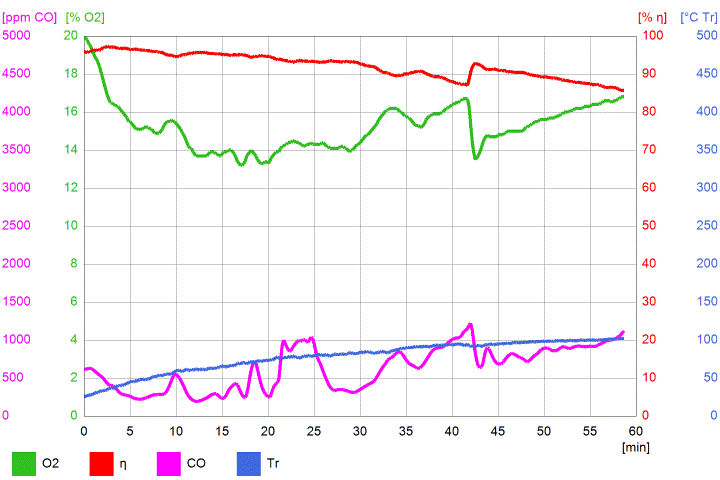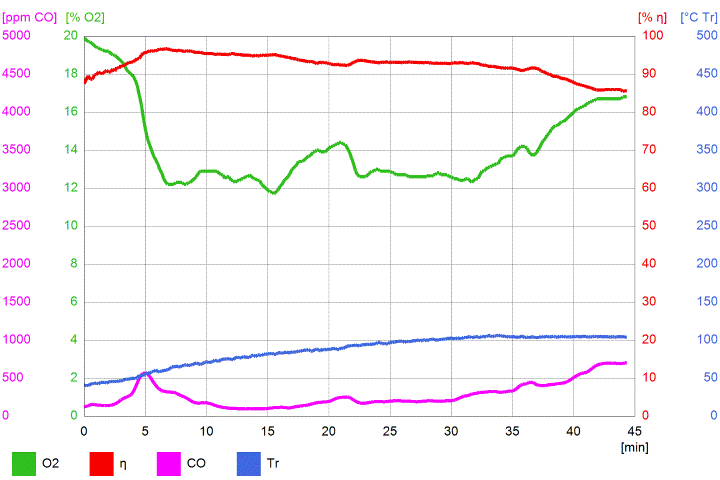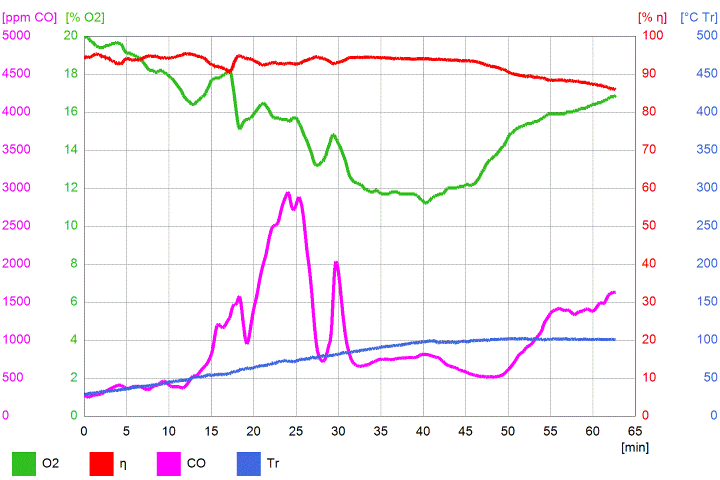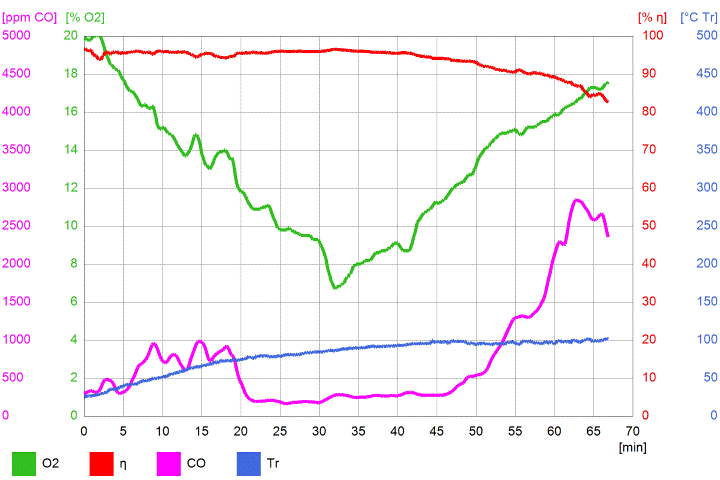|
|
Post by peterberg on Oct 10, 2020 11:27:50 GMT -8
Vortex, I'll keep that in mind, I have some other probe lying around. From the days I tested very temperamental experiments, ending totally clogged up. yasin, No secondary air through the oven door frame, just the air frame in the firebox. The DSR2 is already able to maintain a burn duration of over an hour, this petite core is able to run for an hour and a half on one batch of just 3 kg. Most of my cores were dragracers, powerful in relative short bursts. This core seems to be suited best for a smaller cooking range or a mass-less heater, running less powerful but over a longer time span. Today I took off the top barrel and cut it shorter, minus 25 cm. So ISA dropped from 3.3 to 2.85 m², plus I shove the shelf 30 mm forward since it was longer than needed anyway. I expected a higher chimney temperature, but that happened to be just 10 ºC more than yesterday. Tomorrow I'll open it up again and cut the end port a bit wider, I hope that will lead to a quicker start and higher end temps. One amendment at the time and see what it does.
|
|
|
|
Post by peterberg on Oct 11, 2020 12:46:05 GMT -8
Yesterday I'd cut a ring of 25 cm (10") high out of the top barrel. Fired it with half a batch and bricks on the bottom but was still slow. Today I opened it up again and widened the exhaust port to 180x40 mm, 30% larger as compared to port number one. The burn (half batch as above) developed much quicker now but despite of the double vortex appearing the CO wouldn't go down. No spikes either, but still far too much for my liking.  At 18 minutes into the burn I opened the top door and placed an object on the shelf. A 30 mm high duct, at right angles to the gas stream and from wall to wall. About halfway into the depth of the core, closed the door as quick as possible. Not much difference, the CO line descended a bit and went up again. Judged by the sight of the vortex more air was needed, so I opened the firebox door just a crack at 24 minutes. After just one minute the CO level decreased, roughly from 1850 ppm down to 150 ppm. I closed the door again at 30 minutes but the CO line stayed at the same level for another 18 minutes. Temperature gauging is still not ideal but workable so the above diagram is correct. Next plans: open up the exhaust port fully to the system size csa and do a steel tube of 40 mm high on the same spot on the shelf. This isn't exactly the same as Trevor's because his exit is a bit smaller than system size. But the opening above that tube would be the same 105% of the required end port in Trevor's configuration. And, I might add, in the DSR2 configuration. It seems the distance from the spot where the vortex is spinning is crucial. I might try also the same tube against the ceiling, just because there would be an extra direction change as the result which is also in the Vortex core since this is exiting to the left, not above as in my implementation. We'll see what happens, these seems to be merely tuning problems. It can be very stable and able to very low CO numbers as the above diagram shows. |
|
|
|
Post by Orange on Oct 13, 2020 1:42:30 GMT -8
I like that this core is shorter and if you guys manage lower its height too (by puting exit port on the side, similar to yasin's core) that would be great. Than the whole core could be placed higher which is more convienient for loading and watching flames.
|
|
|
|
Post by peterberg on Oct 13, 2020 2:36:08 GMT -8
I like that this core is shorter and if you guys manage lower its height too (by puting exit port on the side, similar to yasin's core) that would be great. This core is in many ways similar to Trevor's, which incidentally has its exhaust opening to the side. There's no doubt in my mind this particular implementation would work the same way sporting a side exhaust as it is doing now using a top rear exhaust. |
|
|
|
Post by peterberg on Oct 13, 2020 6:36:51 GMT -8
Yesterday, I widened the exhaust port up to its system size, which is 120 mm (4.72"). And placed a 40x30 mm tube on the shelf, the widest side vertical, centered back to front in the top box at right angles with the gas stream. The remaining space almost exactly 105% of the fiebox port. Loaded with about 2.5 kg (5.51 lbs) pine scraps, very dry. It came on moderately quick, the CO line was low in general but wobbled quite a bit, O² stayed in the high region. Not bad at all, although it appeared a bit unstable and around 42 minutes I had to shake up the lowest fuel pieces a bit in order to have those fully burned. Averages: O² 15.2%, efficiency 92.3%, CO 634 ppm, temp 78.2 ºC.  Yesterday evening the core cooled down sufficiently so I could have another go. This time I placed the tubular stumbling block at the ceiling and centered the front of that block in the top box, so it was a bit closer to the exhaust. In an impulsive moment I amended the port in such a way that the underside was longer and the top remaining the same. So now the side facing the front is being angled. This turned out to be a very nice run, CO being low all the time. O² still on the high side, when this line tended to climb I opened the door somewhat. Against what one would expect the O² line went down a bit because of this. Averages: O² 14.1%, eff. 92.5%, CO 279 ppm, end temp 86.1 ºC.  This is very good, as is it would pass the coming European norm with flying colors. |
|
|
|
Post by peterberg on Oct 13, 2020 8:03:57 GMT -8
But as the Dutch expression goes: one single swallow doesn't make summer yet.
So I need to check whether the placement and size of the stumbling block is the crucial factor, or maybe the angled widening of the port. I'm going to "undo" the widening of the port and keep the block in place and run the thing again this evening.
|
|
|
|
Post by Vortex on Oct 13, 2020 10:22:37 GMT -8
Nice run Peter. I get the best results running at around 10% O2. Angling the rear of my port and deepening the afterburner chamber hasn't made any huge difference visually to the double vortex, although it does fill the back of the deeper afterburner, and is possibly less inclined to flame around the front of the shelf. I haven't setup the testo this season yet though.
|
|
yasin
New Member

Posts: 33
|
Post by yasin on Oct 13, 2020 23:16:24 GMT -8
Those are surprising good CO numbers for such slow burns ! Congratulations ! When the results are stable, I think I'll try again to see the results without insulating materials.. but this time with our new (and much more air tight) setup.
Just a note : the process of the norm is different from what you do, the results you have are much better than what they would be along the norm.
In the last burn, let's say that you went down to 11.7% O2, which correlate to 8,99% CO2. Then you would have to wait until you reach 8.99/4 = 2.25% CO2, which correlate to 18,7% O2.. so maybe half an hour more of testing with the CO higher because that's the coal phase.
So in the UE norm, you can only stop at 16.8% O2 if the burn went as fast as 4.0% O2 !
Kind regards,
|
|
|
|
Post by peterberg on Oct 14, 2020 0:13:07 GMT -8
Nice run Peter. I get the best results running at around 10% O2. Angling the rear of my port and deepening the afterburner chamber hasn't made any huge difference visually to the double vortex, although it does fill the back of the deeper afterburner, and is possibly less inclined to flame around the front of the shelf. I haven't setup the testo this season yet though. Trevor, I am quite puzzled why the oxygen level didn't get down. I think there might be a leak somewhere in the barrel setup that I have slapped together. About the angling of the port's front side: there's no separate secondary air provision so air is coming from the firebox itself. Having it angled at the side where the air is fed in could mean more air will enter in the right spot. The block at the ceiling seems to work quite well in combination with the system sized exit opening. No flames around the front of the shelf, that's a good sign. Results of last night are available, I'll deal with that in a separate post. |
|
|
|
Post by peterberg on Oct 14, 2020 0:43:37 GMT -8
Just a note : the process of the norm is different from what you do, the results you have are much better than what they would be along the norm. In the last burn, let's say that you went down to 11.7% O2, which correlate to 8,99% CO2. Then you would have to wait until you reach 8.99/4 = 2.25% CO2, which correlate to 18,7% O2.. so maybe half an hour more of testing with the CO higher because that's the coal phase. So in the UE norm, you can only stop at 16.8% O2 if the burn went as fast as 4.0% O2! Maybe I interpreted the norm the wrong way: I understood the test ends at 4% CO² OR 25% of highest CO² level of that test, whatever comes first. The way you say it is, it would be very hard to get a heater approved. Do you know what the full test requirements are? |
|
yasin
New Member

Posts: 33
|
Post by yasin on Oct 14, 2020 1:11:59 GMT -8
Yes, it is the other way around : the test ends at 4% CO² OR 25% of highest CO² level of that test, and you must use the smallest value of the two. This correlates to the highest corresponding O2 value of the two.
It forces you to test the heater at its full speed, or to settle with average or bad results.
It is true that it makes the approval harder ! But I have no doubts that this core will be able to pass the test with satisfying results. Remember the results of the batchblock V2 I sent you ? We are on average 3.5 times under the CO level of the 2022 EU norm.. and the testings are done along the norm.
There are other requirements and I will try to make you a complete list when I have some time.
Regarding the leaks : I had a very similar problem in the beginning of the year -- my CO levels were very low but the O2 levels were high. The CO was artificially diluted, hence the low values. Now i am sure that this was due to my setup not being enough air tight.. with the new setup the O2 levels are much lower.
Kind regards,
|
|
|
|
Post by peterberg on Oct 14, 2020 2:52:06 GMT -8
Yesterday I re-did the angled front end of he port back to straight and ran the core filled with 2.5 kg of pine scraps. It was slower again, but... the CO refused to go as low as the day before. To the eye, the thing ran not as good, in particular the period between 15 and 27 minutes into the burn. No flames around the shelf though, the double vortex formed completely albeit a bit late. Disappointing results, to say the least. There's no other choice than to bring back the port's slanted front, run it and see what would come out of that.  I have to give Yasin's remarks some thought and end the test somewhat later in order to get a clear picture of how it would fare against the official test. |
|
|
|
Post by Vortex on Oct 14, 2020 6:51:48 GMT -8
I've not found the slanted port front to make that much difference to the testo results, had just as good without as with it, so I would doubt that's it.
High O2 again. Are you running it with the door locked? Something I noticed with my core the first season I ran it was it really didn't like a restricted air flow, ever since then I've been running it with the door cracked open about 2mm until after the peak of the burn.
|
|
|
|
Post by peterberg on Oct 14, 2020 7:56:55 GMT -8
During the burn the door was locked on and off, to see what the effect would be. What the good results triggered I don't know yet. While inspecting the setup this afternoon I discovered the barrels weren't properly taped at the back, which could explain the high O² level.
|
|
|
|
Post by peterberg on Oct 14, 2020 11:26:45 GMT -8
This evening I rigged up the Testo and the experimental core. The angled front end of the port has returned. What Trevor said about having the door ajar all the time got me thinking: the air frame I am using has slits left, right and top, some are taped. I figured the top air would better serve the port as secondary air. So I taped part of the side slits and opened up a small part at the top. This is all around the firebox door, no air is added to the top box at all. I lit the fuel (on top), started the computer and the Testo and began measuring. This turned out to be a very nice run, door was closed around 20 minutes and it ran absolutely fine from then on. Oxygen level went down as hoped for, carbon monoxide didn't spike. I kept in mind what Yasin said about the end definition of official tests and ended the run at 3.4% CO², being 25% of the highest level. Averages of this run: 13.1% O², 93.8% eff., 754 ppm CO, 79.8 ºC. Not bad at all, good enough for the new norm and way better than the present. I get the feeling I come closer now, tomorrow a second run, maintaining this exact configuration.  |
|